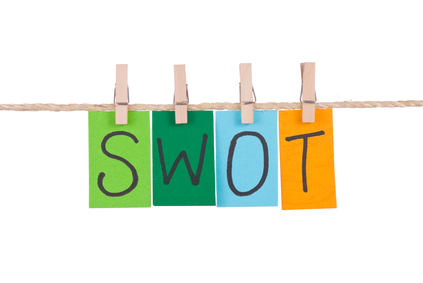I know, I know. You’ve been waiting with bated breath all week for the next riveting instalment in our core marketing concepts series. Well, take a breath. There’s no need to wait any longer; it’s here! Today we are going to take a sneak peak at the concept of SWOT analysis (Note: this should in no way be confused with the burly-looking SWAT teams that arrive in full body armour in all American action film produced in the last 20-odd years).
SWOT analysis is a means by which to monitor both the internal and external marketing environments of a company, a person, a product, a place or even a whole industry. It is a structured planning process used to evaluate Strengths, Weaknesses, Opportunities and Threats:
- Strengths: characteristics of a company that give it an advantage over competitors
- Weaknesses: characteristics of a company that place it at a disadvantage to competitors
- Opportunities: elements that a company can exploit to its advantage (increasing profitability)
- Threats: elements that may cause challenges for a company (decreasing profitability)
Internal Environment (Strengths and Weaknesses Analysis)
It is one thing to be able to find attractive business opportunities, but quite another to be able to capitalise on them. To capitalise on available opportunities, a company must be self-aware; every company needs to evaluate both its internal strengths and weaknesses.
Strengths and weaknesses can be evaluated in a number of ways. A simple checklist (including items like reputation, market share, customer and employee satisfaction and retention, product quality, service quality, pricing effectiveness, distribution effectiveness and financial stability) can be quite effective, if the company (or the company’s owner or marketing team) can be objective and realistic.
A company does not need to correct all its weaknesses, nor gloat about its strengths. The big question is whether it should limit itself to those opportunities for which it already possesses the required strengths, or consider those opportunities that require new (or at the very least improved) strengths.
External Environment (Opportunity and Threat Analysis)
More often than not, companies that are ahead of the game monitor key macro-environment forces as well as significant micro-environment factors that may affect its ability to earn profits. This monitoring can be done in any number of ways. You can establish a marketing intelligence system to track trends and industry developments and their related opportunities and threats. You can implement employee and customer surveys. You can undertake competitor analysis. Whatever means of monitoring you go with, the important thing to remember is that good marketing is the art of finding, developing and profiting from the opportunities that arise from macro and micro environmental forces.
But what is a marketing opportunity, I hear you ask. Well, a marketing opportunity is an area of customer need or interest for which a company has a high probability of profiting. There are three main sources of market opportunities:
- Offer a product that is in short supply: as you might expect, this requires little to no marketing talent; the need is fairly obvious and just waiting to be fulfilled.
- Supply an existing product or service in a new or superior way: the best way to do this is to ask customers for their suggestions. Get them to image the ideal version of the product or service.
- Create a brand new product or class of products: companies can use the consumption chain method to do this; customers are asked to outline the steps they usually take in acquiring, using and disposing of a product.
Once an opportunity has been identified, companies must undertake Market Opportunity Analysis (MOA) to determine the likelihood of profitability and success. This can be done by asking questions like:
- Can we articulate (convincingly) the benefits of our new and improved product or service to a specific target market(s)?
- Can we pinpoint the target market(s) and reach them through cost-effective media, marketing and trade channels?
- Do we have (or can we access) the capabilities and resources we need to deliver the customer benefits?
- Can we deliver the benefits better than our competitors?
- Will the financial return exceed (or at the very least meet) the investment we will need to make?
Now, onto threats a quick definition of threats. (We won’t go into too much detail as we presume you can probably work out what a threat is all on your own!) An environmental threat is a challenge posed by an unfavourable development that (without defensive action) may lead to a drop in sales or profit. Smart, forward-thinking companies will have contingency plans in place to deal with threats. Depending on the nature and size of the company, these plans might range from crisis communication strategies (think ExxonMobil oil spill) to alternate widget suppliers.
Marketing.com.au would like to thank Sally for sharing with us Part 3 of this Core Marketing Concept Refresher series. If you missed them, don’t forget to check out Part 1 Core Marketing Concepts Refresher: The Value Chain and Part 2 Core Marketing Concepts Refresher: Two for One.
About Sally Wood
Having worked in marketing, communications and public relations roles for over ten years, Sally’s past life includes a plethora of activities, some of which even she can’t believe she was lucky enough to try her hand at. There was the development and implementation of internal communication programs for burly construction contractors; PR campaigns to launch The Simpson’s products (which just happened to involve carting life-sized Simpson figures around the country); people (and media) wrangling at Flemington’s birdcage for high-profile clients during the Melbourne Cup Carnival; CSR program design, implementation and GRI-accredited reporting; and, most recently, copywriting and internal stakeholder relations in a most serious corporate environment. Somehow, in the midst of all that, she also managed to get stuck into some study, undertaking a Bachelor of Arts / Law, completing a Postgraduate Bachelor of Letters in Public Relations and Journalism and recently starting an MBA.
